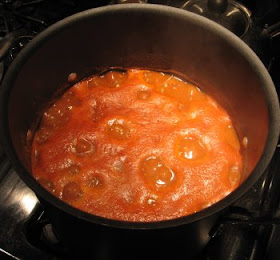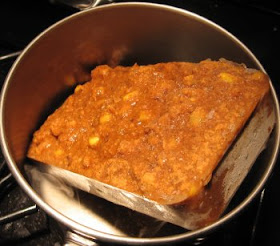
New year's is the best possible day to make a gigantic pot of chili, eat a lot of it, and freeze the rest of it for future chili consumption. Not that we ever make a tiny amount of chili with no intention of preservation: it's always best in a giant pot that bubbles for hours, with chili fumes making you hungrier and hungrier until you can't stand it anymore. Then you can eat as many bowls as you want before packing the remnant up and gloating over how much is still left.
The freezer is by far my favorite preserving device. I wonder how well it would work to can something like this, though? The tomato is clearly acidic enough to be canned on its own. Research necessary.
 It's January chili
It's January chilionion
garlic
olive oil
carrot
celery
hot pepper
green/other bell pepper
black beans
red beans
garbanzo beans
tomato puree/other
veg broth
tvp
corn
cayenne, cumin, paprika
salt, pepper
You can use as much of each ingredient as you want in this situation. For our huge pot of chili: 1 huge onion, five or six cloves of garlic, 1 huge carrot, no celery actually, two jalapenos, 1 green pepper, probably about four cups of collective beans, a 24-oz can of tomato puree, maybe 2/3 cup of tvp, an entire small bag of frozen corn, lots of cumin, paprika, and black pepper, and a little cayenne and salt. The broth quotient is negotiable based on how liquid you like your chili.
OK LET'S GO
Get out your biggest, deepest pot, heat some olive oil in it, and throw in chopped onion, garlic, carrot, celery, and hot pepper to soften. Spice with cumin and paprika, plus a little cayenne if you want it, to start.
Save the peels and root/stem ends from the onion, garlic, carrot, and celery. Put them in a separate pot with some water and whatever odds and ends of vegetables you have collected in your stockpile/at the bottom of the crisper. Good things to add: mushrooms, potato, spinach or parsley stems, winter greens. Stay away from cabbage, broccoli, and any strong flavored vegetables. Make sure the vegetables are covered with water, cover the pan, and simmer to make veg broth. Easy! You're also making food out of trash, which is highly satisfying.

As the onion mix softens, chop and add any other vegetables you want in your chili. I think green pepper is absolutely necessary; other peppers are also good. If you have fresh tomatoes, chop and add them at this point too. Corn can go in now or it can wait until nearly the end of cooking.
Once all the vegetables that need to soften are softened, add any canned tomatoes and the beans. We used a combination of precooked dried beans and canned beans. For canned beans, I waver between rinsing all the can broth out or just adding it. I'll add black bean broth, for instance, but rinse garbanzos since their "broth" is more like "slightly slimy water". For the beans I've cooked myself, all the broth goes in, especially because I usually freeze the beans in their broth and then whack the entire frozen block into the chili.
Also add the tvp, if you want and have it. Chili is clearly fine with just beans/tomato/pepper, but if you want chewy bits and extra protein content, tvp is an excellent way to go. We use dry tvp as opposed to the freezer crumbles.
At this point we need to add some water or broth to keep things liquid and prevent burning. Open your broth pot, lower a measuring cup in with its mouth against the side of the pan, scoop up a bunch of hot broth, and add it to the chili. Do this several times to get a lot of the liquid out. Since tvp soaks up an incredible amount of liquid, make sure the pot is appropriately overwet and soakable; you can add water too if you run out of broth.
Add some more water to the broth pot and keep it simmering for any later liquid additions, and/or to have leftover broth to freeze along with the leftover chili.
Bring the chili to a boil, do a second round of spicing, and leave the entire business (covered, on low) to simmer while you go do something else. Leave it for at least an hour, checking occasionally to stir the solids off the bottom and make sure that everything smells appropriately delicious.
When you can't stand it anymore, it's time to make a couple decisions. John likes chili very smooth, so we tend to puree ours. This is actually why we add corn at the end: so we can have the corn bits floating around in the otherwise smooth chili. I like chunky stewy chili better, so I serve myself a bowl before we attack the pot with the stick blender. Normally I'd just leave it as is and eat it, though.

Eat as much chili as possible.
Supplements:
- toast
- cornbread/muffins
- chips to dip in it (a point in favor of puree here)
- sauteed dark greens
- sour cream/plain yogurt
- cheese if you feel the need
Freeze the rest of the chili. We pour it into tupperware, let it cool down for a while, then stick it in the freezer. The end. For this batch, we both ate at least two bowls of chili, which left a little more than half the pot to pack up. Now every time you want chili, you can pop a brick of it out of your freezer.

Reheating: ok, we don't have a microwave, so we always reheat in pots on the stove. Put an inch or two of water in the bottom of a pot, add the brick of chili, and turn on the heat. Steam/boiling water will soon envelop the chili, melting it down. It's really important to use water; otherwise, since a lot of water evaporated in the initial cooking, there might not be enough moisture, and the chili might burn. Also there's the part where steam is hotter than water, so steam will help the brick defrost faster. Physics!